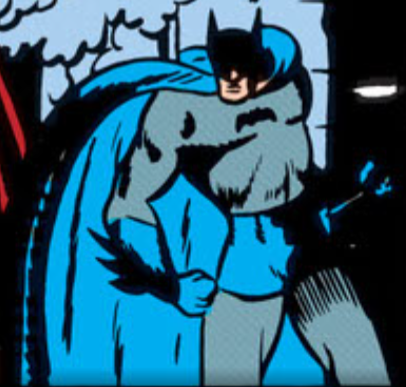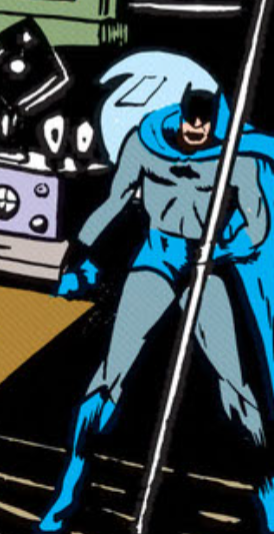Spring has sprung and I am called forth once more from the void to write my silly little Batman blog that no one will ever read. And yet, how can I read ancient Batman comics and not share all of the little treasures inside in hopes of some future traveler one day finding them and doing a little chuckle. A little “hehe,” if I’m bold, maybe even a “haha.” Let alone, a “wow, neat.” But I’m getting too big for my Bat-Britches.
There’s three more whole stories in here to write about. But I’m just gonna give you the best, most unhinged bits.
Story 2: Professor Hugo Strange and the Monsters
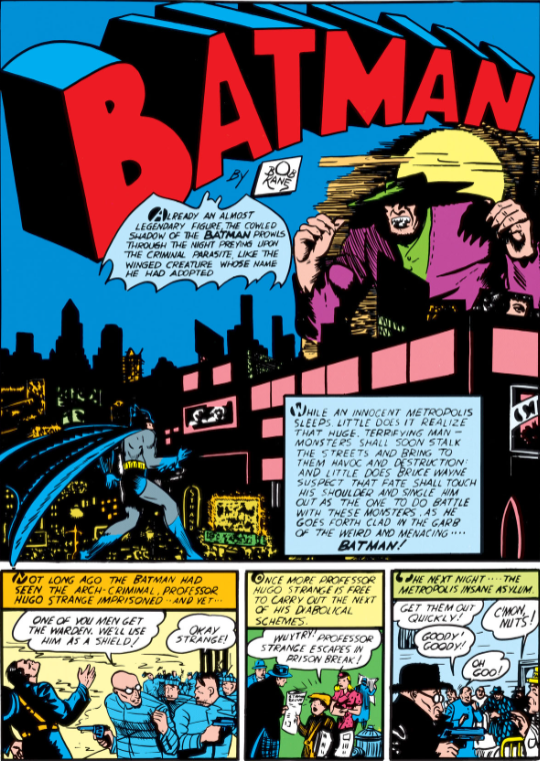
Hugo Strange is breaking out of the prison he was just put into a few issues ago. He then breaks into an “insane asylum” and frees all the “nuts.” You can tell they are both excited and cRaZy because they say things like, “Goody! Goody!” and “Oh, goo!” But don’t be fooled, the events which follow are neither goody goody nor goo.
Not long after the break-out at the insane asylum, fifteen-foot tall monsters begin terrorizing the city.
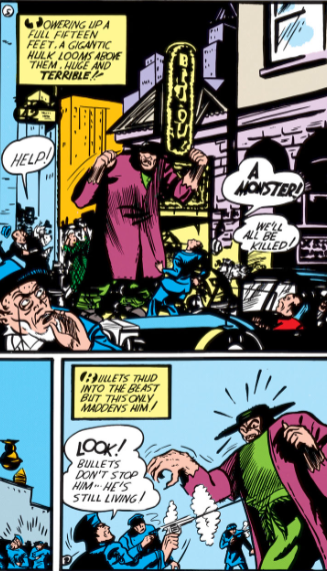
Wha! Huh? Where did these monsters come from, you cry, astonished. Certainly Hugo Strange couldn’t be responsible! Well, Batman has a Bat-Hunch that he is, so he does the thing we all love: flies around in his little plane and finds Strange’s hideout.

Wait-a-second, you say, interrupting me AGAIN. I don’t remember there being a MACHINE GUN mounted to the Bat-Gyro. Yeah, neither do I, but it’s probably nothing and I wouldn’t worry about it at all.
So, Batman lands, approaches the house and goes, “This is probably a trap, but I gotta risk it.” He is, predictably, immediately entrapped.
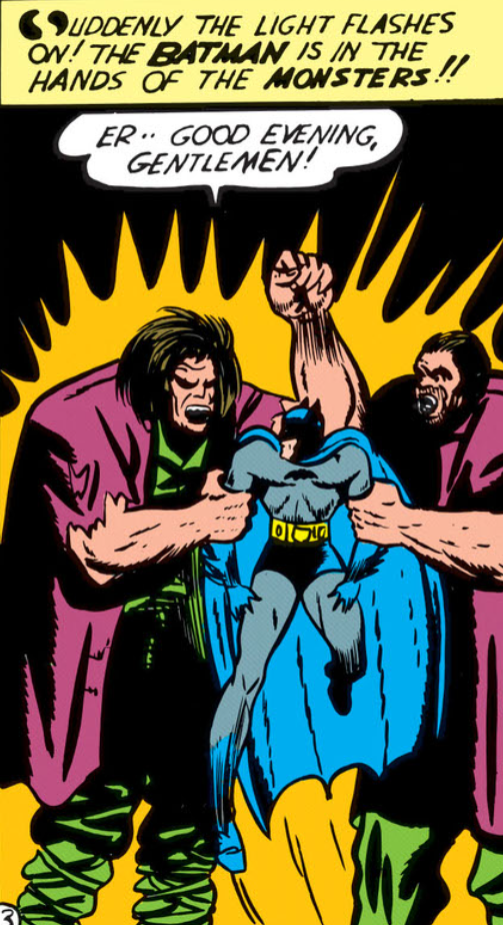
First of all I love Batman saying, “Er… Good Evening, Gentleman,” like a stand-up comic in front of a tough crowd. What a sassy little queen.
And would you believe it? His Bat-Hunch was right! It turns out that Hugo Strange “discovered an extract that speeds up the growth glands” and he used it on all of the escaped “lunatics” he broke out of the asylum. The serum apparently “distorts the body but also the brain.” I don’t know what that means, but neither does Hugo – “Soon he is a MONSTER!” he cries.
I also just need to point out that at some point in the chaos, Strange made his “monsters” not only gigantic fifteen-foot tall clothes and coats but also giant hats, as we saw earlier. That’s how you know you’re dealing with a supervillain. Were these massive hats necessary? If you’re even asking that question, you’re just not seeing the aesthetic vision here and I don’t know what to tell you.

Anyway, Strange injects Bruce with the serum, giving him eighteen hours before it takes fatal effect! That’s a decent amount of ti-

Batman actually gets hit in the face this time, so it’s not technically a blackjacking. But the tradition of Bat-Head Trauma continues apace.
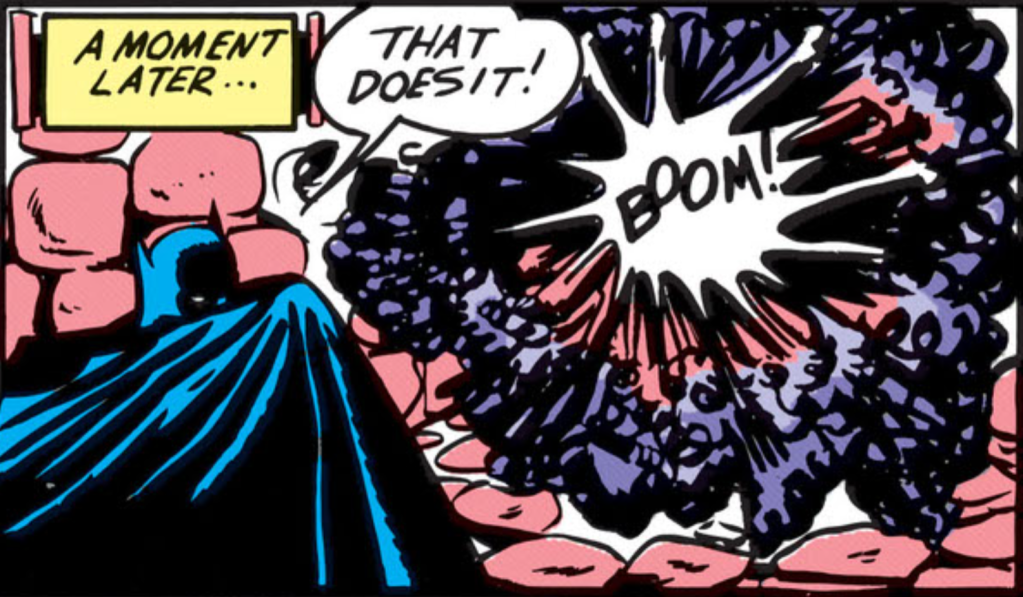
Don’t worry, Batman had explosives in the heels of his boots and after almost eighteen hours he woke up from his semi-coma and exploded his way out of his cell. The Joker will do this two stories later, except he puts his portable explosive chemicals in his teeth.
So far, there’s a lot going on in this issue. Most importantly, we’re not dealing with… an especially sensitive treatment of mental illness in this story. Certainly, the most horrific aspect of this issue is Strange using a vulnerable and marginalized population as experimental test subjects and disposable zombie-like crime slaves. But don’t worry, surely Batman will find a cure to save himself and reverse the terrible afflictions Strange has visited upon his unwitting victims/accomplices, right? Certainly, the script in its final resolution will reveal Strange’s dehumanization of the mentally ill as a prime example of the evil Batman is fighting against, right? RIGHT?

Well, hold your understandably concerned horses for a minute. First, Batman’s gloves disappear and he punches Strange off a cliff, to what we can only assume is his certain death. Making me nervous again, Batman.
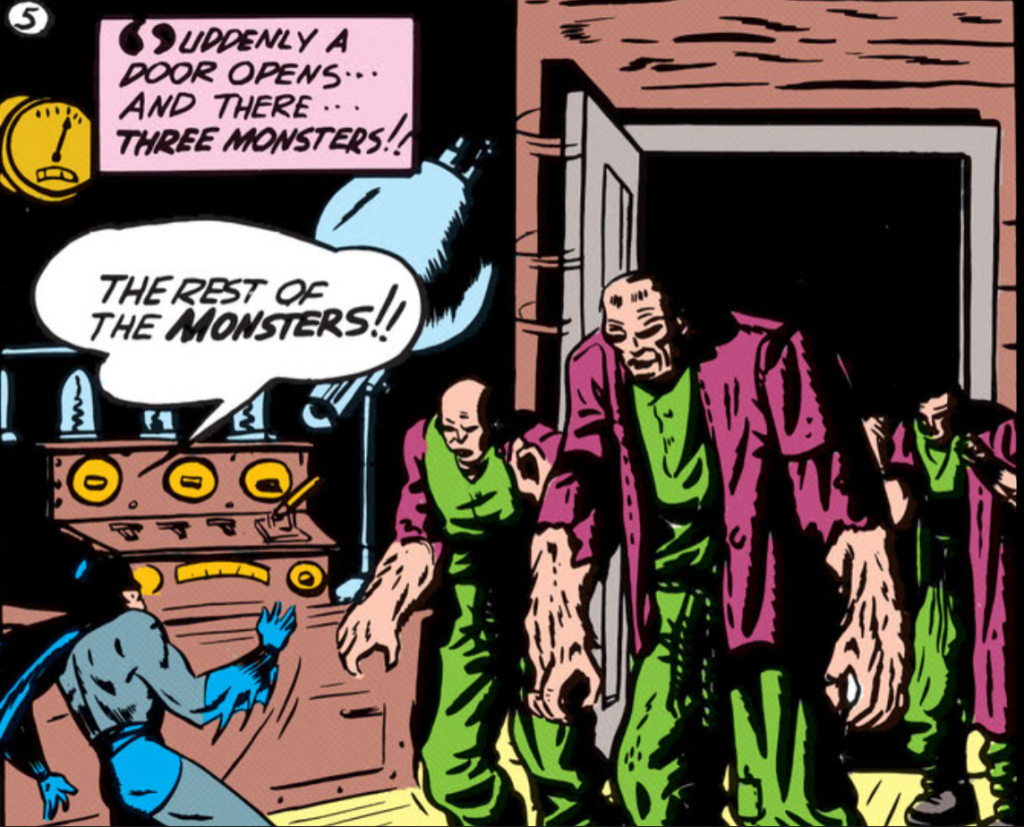
The “monsters” show up. Batman uses a giant stick to confuse them and they start fighting each other. With valuable time bought by this distraction, he has time to do some last-minute, high-stress science.

Soon, everyone will be safe! Right???
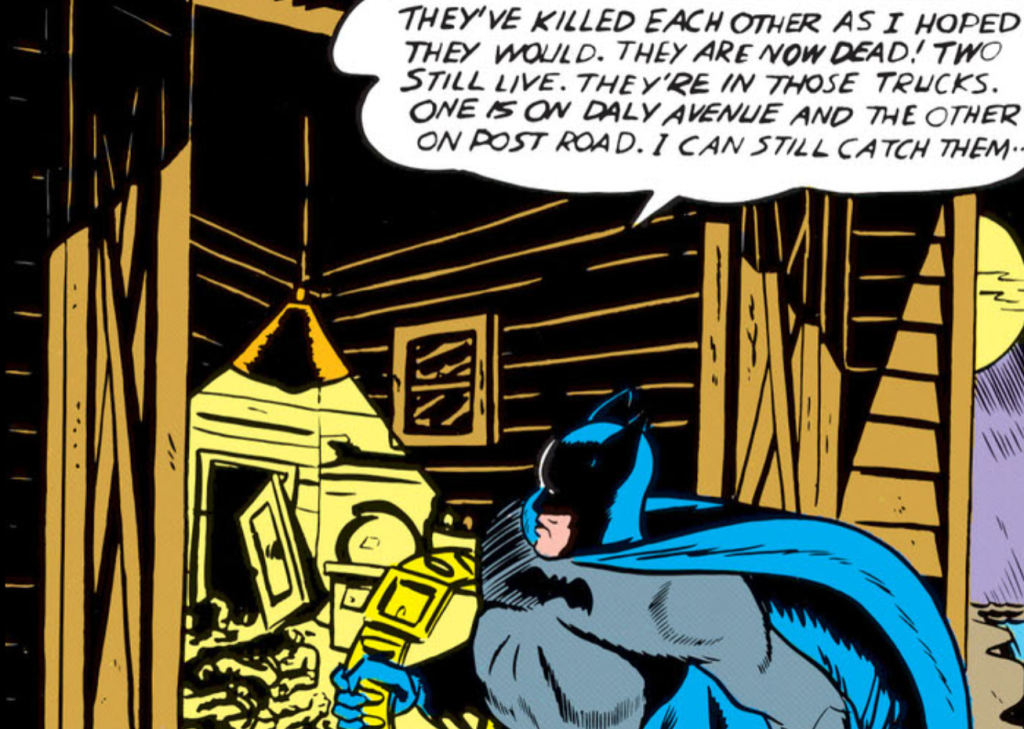
NO! Of course not! They killed each other! Exactly as Batman “hoped!”
They are now dead.

Batman gets into his little plane to chase down the remaining monsters, being transported by thugs in trucks to the sites of their future intended crimes. How will Batman stop them? Uhhh, just watch for yourself.


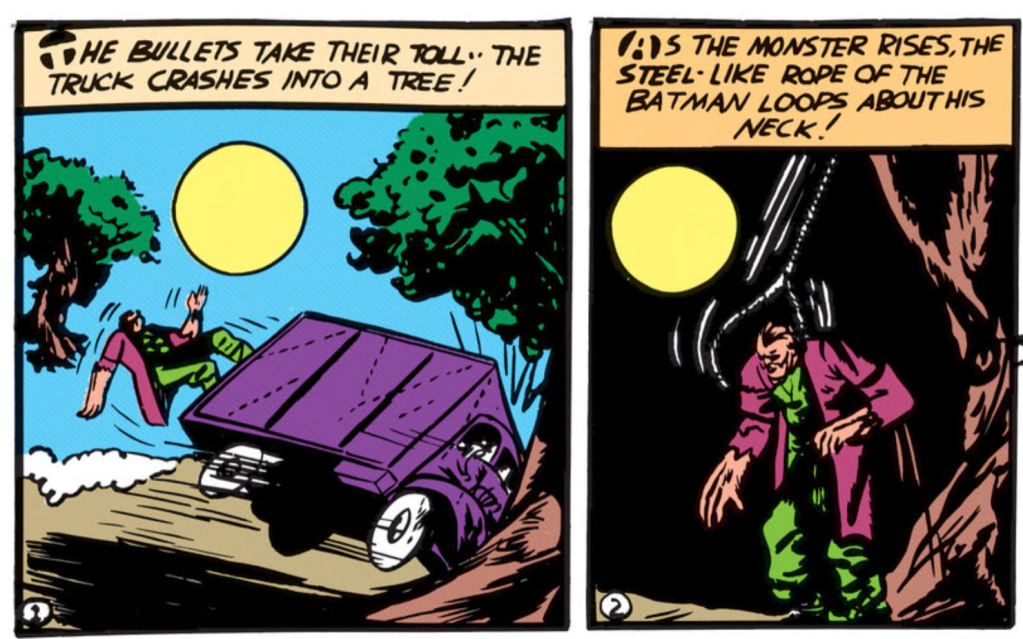
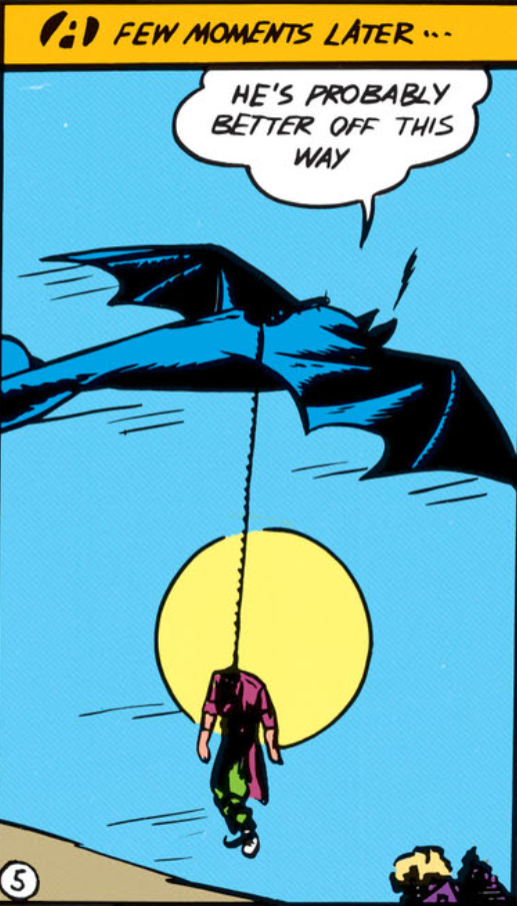


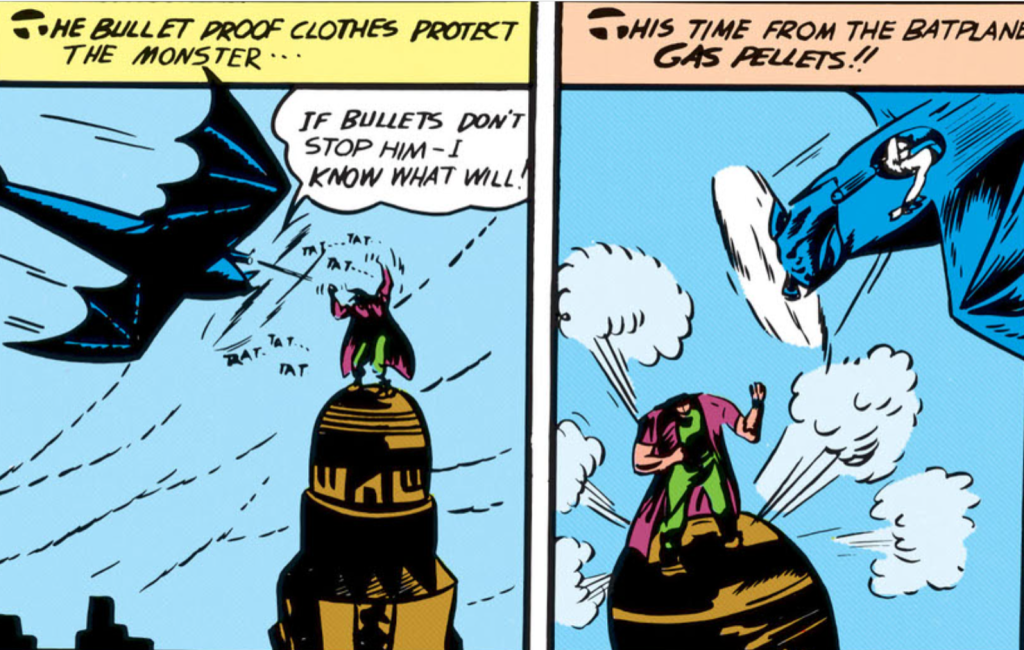
Yeah.
Batman is off the fuckin goop in this issue. We had just gotten a few issues where Batman seemed to stop killing. And here he is machine-gunning people down, HANGING THEM from his plane, and gassing them to death. It is possible that this could be explained by the fact that this issue was originally intended to be released earlier as DC #38, before Robin’s introduction (he is noticeably absent here). When Robin appears things start to lighten a little bit.
I think one of the most fascinating parts of early Batman is the way it borrows from the movies. Batman himself must be at least partially pulled from Roland West’s The Bat and The Bat Whispers. The Joker’s design famously references Conrad Veidt in The Man Who Laughs. And we’ll see this most overtly in the first Clayface story in DC #40. Here, the last monster’s death scene clearly evokes King Kong from 1933. And Hugo Strange’s “monster men” recall any number of 30s horror film tropes: hypnotism, zombies, killer apes. But Strange’s “speed up the glands” speech most sounds like, to me, Dr. Moreau’s description of his scientific project in The Island of Lost Souls from 1931. In that movie, Moreau has found a way to accelerate evolution, turning animals into human-like creatures. The effect in this issue is kind of the reverse, though – which, in turn, echoes the many movies that deal with the “reversion” of men into beasts, like Werewolf of London or the various Jekyll and Hyde movies.
But, in Island of Lost Souls, one of the most striking scenes is when Moreau calls upon his creatures to speak “The Law,” a series of commandments, such as “do not shed blood.” Each law is answered with the creatures shouting in unison, “Are we not men?” Embedded in the movie is an understanding that these creatures are the mad scientist’s victims. What at first, for Moreau, is a means of control becomes a cry for their humanity to be recognized. And Kong’s death scene is no less tragic. It’s characteristic of 30s horror to depict the tragedy in its monsters. Even the worst “monsters” are often depicted with a kind of tragic empathy.
This issue borrows a lot from the movies but it has no room for the weightier existential tragedy it should invoke. The subjectivity of the “lunatic” who is physically and psychologically “distorted,” which we might expect to find in even a then contemporary film, is completely absent here. So, ultimately, we have an issue where Batman openly acknowledges that actually some people are too far gone and all we can do is kill them – they might even be “better off that way.” For both Batman and Strange, the marginalized end up disposable or instrumental. Which is totally upsetting. It’s also the the most extreme example of Batman before his “no guns, no killing” code so far. As over the top as this story is, it’s also maybe the bleakest one I’ve read yet.
Apparently, Bill Finger agrees, specifically regretting this story and acknowledging that Batman could have resolved things without killing. The “no killing” rule, from what I gather, emerges much sooner than I anticipated, being stated overtly in Batman #4. Batman’s reputation in some circles for being a vigilante who beats up the vulnerable is, unfortunately, entirely deserved in an issue like this. But a refusal to kill anyone for any reason radically alters the moral universe in which Batman operates. That Polygon article pulls these panels from Legends of the Dark Knight Annual #1:
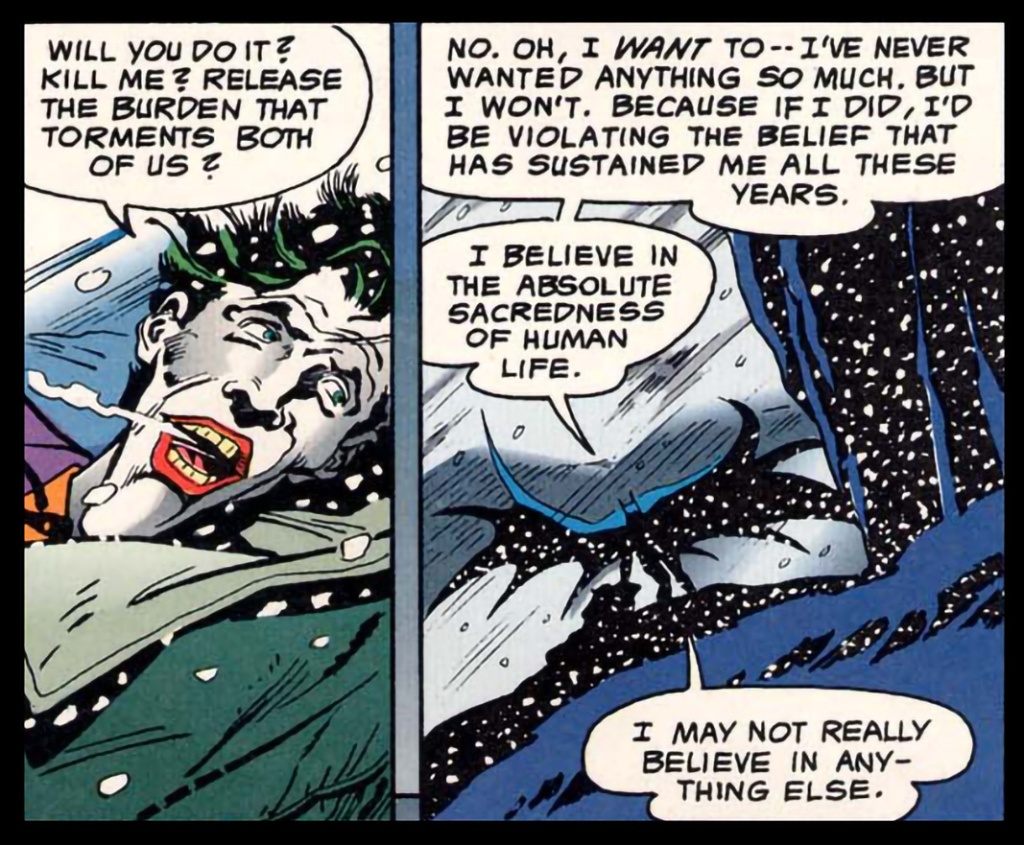
It is this belief in the sacredness of human life that defines Batman for me. It doesn’t seem like any of this mattered to Bob Kane. But it did to Finger. Without this aspect of his character, Batman has no human or moral center. He’s just a vigilante, at best no different from those he fights, at worst, worse because he has a choice to do otherwise. If you believe that every life is sacred, you can at least believe in the possibility of redemption, you can at least have a genuine kind of hope that things can change for the better.
Someday, I’ll read the 2006 “Batman and the Monster Men” to see how this is handled in the Year One era. But for now, I’m interested to see where any flickers of that compassion will appear in future issues, any peek into the interiority of the victimized, any identification with those who do evil. At his best, Batman’s character grapples with his own contradictions. In his ultimate refusal to dehumanize others, I imagine, lies a fundamental recognition that in some essential way he is both Joe Chill and Joe Chill’s victim at once. But there’s 80 years of continuity that explore this a thousand ways back and front, the surface of which I can barely begin to scrape in a few words here.
For now, I will lighten these sombre notes with my favorite part of every post, the weirdest little Batmans in this issue:
